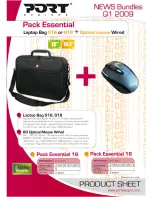
4-2 Field Service Guidelines
3.
Clean the keys with a damp cloth. A small, soft-bristle brush may be used to clean
between the keys. Make sure to use a damp cloth (not wet) to prevent moisture
from seeping between the keyboard and the metal plate, possibly damaging the
components under the keys. If the keyboard gets wet, thoroughly dry it before re-
assembling the system unit.
Cleaning the Notebook’s Interior
When servicing the inside of the notebook, remove dust and other foreign particles from in-
side the system unit as follows.
1.
Remove the top cover and keyboard using the disassembly procedures discussed
later in this section.
2.
Dust or vacuum (with a rubber-tipped nozzle) the inside of the system unit par-
ticularly the motherboard surface. Use care to avoid damaging or dislodging any
components or cables.
3.
Inspect all cables connectors for damage. Ensure that connectors are seated prop-
erly before replacing the cover.
Protecting the Disk Drives
To protect the disk drives and data, back up the system disk periodically on diskettes. Peri-
odically use a head-cleaning diskette in the disk drive to prolong the life of the drive and to
help maintain data integrity.
Here are some maintenance procedures to use when servicing a hard disk:
Always back up the data files from the hard disk.
Run a virus detecting program to check for possible virus infected areas on the
hard disk.
Use the preinstalled ScanDisk program to correct any errors found in the direc-
tory and File Allocation Table (FAT). This will also free up space from any un-
used sectors.
Never turn the computer off when the hard disk is being accessed.
Never move or raise the computer while the hard disk is being accessed, most es-
pecially don't jar the hard disk as this may cause a hard disk crash.
Acquire a hard disk maintenance program like DEFRAG under DOS, or Norton
Utilities SPEEDISK programs. These programs reorganize your hard disk by
eliminating fragmentation and improves the hard disk access time.
















































